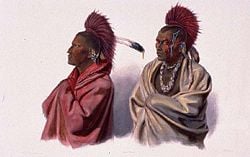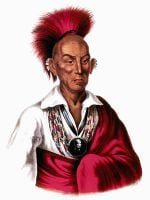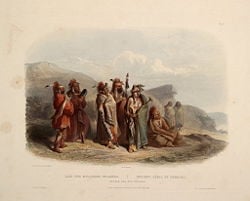Fox (tribe)
| Sac & Fox |
|---|
Flag of the Sac and Fox of the Mississippi in Oklahoma Flag of the Sac and Fox of the Mississippi in Iowa |
| Total population |
| 3,500 |
| Regions with significant populations |
| United States (Oklahoma, Kansas, Nebraska, Iowa) |
| Languages |
| English, Sauk, Fox |
| Religions |
| Christianity, other |
| Related ethnic groups |
| other Algonquian peoples |
The Fox tribe of Native Americans are an Algonquian language-speaking group that are now merged with the allied Sac tribe as the Sac and Fox Nation. The Fox called themselves Meshkwahkihaki, Meskwaki, or Mesquakie. The name Fox originated in a French mistake applying a clan name to the entire tribe, and was perpetuated by the US government.
History
The Fox originally lived east of Michigan along the Saint Lawrence River. The tribe may have numbered as many as 10,000 but years of war with the French-supplied Hurons reduced their numbers and forced them west first to the area between Saginaw Bay and Detroit in Michigan and then to Wisconsin. In Wisconsin the Fox gained control of the Fox River system. This river was vital for fur trade between French Canada and the interior of North America, because one could navigate from the Bay of Green Bay in Lake Michigan to the Mississippi River. By going down the Fox River to Lake Winnebago, through the Wolf River one could reach a small portage (at the present day city of Portage, Wisconsin) to the Wisconsin River. From the Wisconsin River, traders could reach the Mississippi River and ultimatley the rest of the continent. When the French had first contact with them they estimated that the Fox numbered about 6,500. By 1712, they were down to 3,500 when the First Fox War broke out with the French (1712-1714). The Second Fox War of 1728 found the remaining 1500 Fox reduced to 500 who found shelter with the Sac and brought French animosity to that tribe. The First Fox War was purely economic in nature. The French merely wanted rights to use the river system to gain access to the Mississippi. The Second Fox War was genocidal because the Mesquakie continually refused to allow traders onto the Fox and Wolf rivers.
Members of the Fox tribe spread through southern Wisconsin, and the Iowa-Illinois border. In 1829 the government estimated there were 1500 Fox (along with 5500 Sac). Some of them were involved with some of the Sac in the Blackhawk War when they refused to give up their lands in Illinois.
The Black Hawk War was fought in 1832 in the Midwestern United States. The war was named for Black Hawk, a war chief of the Sauk, Fox, and Kickapoo Native Americans, whose British Band fought against the United States Army and militia from Illinois and the Michigan Territory (present-day Wisconsin) for possession of lands in the area.
Fox who had successfully fled west of the Mississippi River were known as the "lost people" by the Dakota. The Sauk and Mesquaki (Fox) were induced to sell all their claims to land in Iowa in a treaty of October 1842. They moved west of a temporary line in 1843 and to land in Kansas in 1845. Many Meskwaki later moved to a settlement near Tama, Iowa that was started about 1856. Soon after the Sauk were forced to a reservation in Indian Territory, now Oklahoma. By 1910, there were only about 1000 Sac and Fox altogether and, even by 2000, their number was less than 4000.

Meskwaki means "The people of red earth." The Meskwaki are of the Algonquian origin from the Eastern Woodland Culture areas. Their language is a dialect of the same larger language spoken by the Sauk and Kickapoo. The tribe has been historically located in the St. Lawrence River Valley, Michigan, Wisconsin, Illinois, Missouri and Iowa. Meskwaki were called “Renards” (The Fox) by the French – the tribe's first European contact in 1666 – but have always identified themselves as “Meskwaki.” The Anishinaabe peoples called the Meskwaki Odagaamii, meaning “people on the other shore,” which the French also adopted as “Outagamie” as a name for the Meskwaki. This name survives today for Outagamie County of Wisconsin.
Meskwaki and Sauk are two distinct tribal groups. Linguistic and cultural similarities between the two tribes have made them often associated throughout history. Terminology established by the United States Government continues to treat the Sac & Fox as a single political unit despite their separate identities.
Meskwaki fought against the French in what is called the Fox Wars (1701-1742). The Meskwaki resistance of French rule was so effective that the King of France signed a decree commanding the complete extermination of the Meskwaki—the only edict of its kind in history of a Major and full standing army on one particular Native American tribe. The Sauk and Meskwaki allied in 1735 to fend off Europeans and other Indian tribes. Both tribes moved southward from Wisconsin into Iowa, Illinois, and Missouri.
After the Black Hawk War of 1832, the United States officially combined the two tribes into a single group known as the Sac & Fox confederacy for treaty-making purposes. Then a series of land cessions under the name of “Sac & Fox,” the Sauk and Meskwaki lost all lands and ultimately were removed to a reservation in east central Kansas in 1845 via the Dragoon Trace. But some Meskwaki remained hidden in Iowa with others coming back within a few years. In 1856 the state of Iowa enacted a law allowing the Meskwaki to stay. The U.S. government however tried to force the tribe back to the Kansas reservation by withholding treaty-right annuities. Government officials declared that the Mesquakie coudn't own land because legally Indians weren't people.
In 1857, the Meskwaki purchased the first 80 acres in Tama County. Ten years later, the U.S. finally began paying annuities to the Meskwaki in Iowa, an act that gave the Meskwaki a formal identity as the Sac & Fox of Iowa. The jurisdictional status was unclear since the tribe then had formal federal recognition with eligibility for BIA services but also had a continuing relationship with the State of Iowa due to the tribe’s private ownership of land which was held in trust by the governor. For the next 30 years, the Meskwaki were virtually ignored by federal as well as state polices. Subsequently, they lived a more independent lifestyle than other tribes confined to regular reservations that were strictly regimented by federal authority. To resolve this jurisdictional ambiguity, in 1896 the State of Iowa ceded to the Federal Government all jurisdiction over the Meskwaki.
Culture
The Fox of the eastern woodlands were migratory farmers who lived in summer villages of bark houses, and cabin-style lodges in the winter. They produced wild rice, corn, squash, beans, and tobacco.
The Fox used what was called mŭnǐtowǐwi, which was a divine substance that could allegedly animate objects when this substance was applied. Many ceremonies were held traditionally such as harvest feasts, spiritual and war dances, and equinox and solstice rituals, atypical to many Algonquin tribes. They were renowned for their courage and bravery in battle, and like most of the regional tribes of the great lakes, the Foxes were polygamists.
The Fox were a warlike tribe, described by neighboring tribes as troublesome, thieving, and passionate. The Fox were proficient craftsmen with both dug-out and birch-bark canoes, which is why their trade industry flourished. Their weapons of choice were spears and clubs. Fox warriors often wore headdresses made out of horsehair which was dyed crimson for effect, and tied to resemble the shape of ancient Roman Helmets. The rest of the head was covered in warpaint, and the hair was completely shaved on the sides, and they often bore feathers in their scalplocks. Their upper bodies were often painted, and they wore breeches, moccasins and leather wraps for leggings.
Contemporary Fox
The Sac and Fox Nation is the modern political entity encompassing the historical Sac and Fox nations of Native Americans. The tribes were always closely allied and speak very similar Algonquian languages, sometimes considered two dialects, instead of two languages. The Sac call themselves Asakiwaki (or Osakiwug) which means "people of the yellow earth" while the Fox call themselves Meshkwahkihawi meaning "people of the red earth."
The tribe has multiple separate groups and reservations. The main group, the Sac and Fox of the Mississippi in Oklahoma moved to near Stroud, Oklahoma in 1869 where they have about 2500 members and an 800 acre (3.2 km²) reservation.
A smaller group (called the Sac and Fox of the Mississippi in Iowa or the Meskwaki) returned to their Iowa lands where they now have about 700 members and 4,165 acres (16.854 km² / 6.507 sq mi) in Tama County, Iowa near the city of Tama. There was a resident population of 761 persons on the Sac and Fox/Meskwaki Indian Reservation at the 2000 census.
The Sac and Fox Tribe of Missouri separated from the main band in the 1830's and has 360 members and a 61.226 km² (23.639 sq mi) tract in southeastern Richardson County, Nebraska and northeastern Brown County, Kansas, near Falls City, Nebraska. The Sac and Fox Indian Reservation had a resident population of 217 persons at the 2000 census.
Jim Thorpe, the famous athlete, was a member of this tribe.
ReferencesISBN links support NWE through referral fees
- Edmunds, R. David and Joseph L. Peyser. 1993. The Fox Wars: The Mesquakie Challenge to New France. University of Oklahoma Press. ISBN 978-0806125510
- Hagan, William Thomas. 1988. The Sac and Fox Indians. University of Oklahoma Press. ISBN 978-0806121383
- Waldman, Carl. 2006. Encyclopedia of Native American Tribes. Checkmark Books. ISBN 978-0816062744
External links
- Sac and Fox/Meskwaki Reservation and Off-Reservation Trust Land, Iowa; Sac and Fox Reservation and Off-Reservation Trust Land, Nebraska/Kansas United States Census Bureau
Credits
New World Encyclopedia writers and editors rewrote and completed the Wikipedia article in accordance with New World Encyclopedia standards. This article abides by terms of the Creative Commons CC-by-sa 3.0 License (CC-by-sa), which may be used and disseminated with proper attribution. Credit is due under the terms of this license that can reference both the New World Encyclopedia contributors and the selfless volunteer contributors of the Wikimedia Foundation. To cite this article click here for a list of acceptable citing formats.The history of earlier contributions by wikipedians is accessible to researchers here:
The history of this article since it was imported to New World Encyclopedia:
Note: Some restrictions may apply to use of individual images which are separately licensed.



